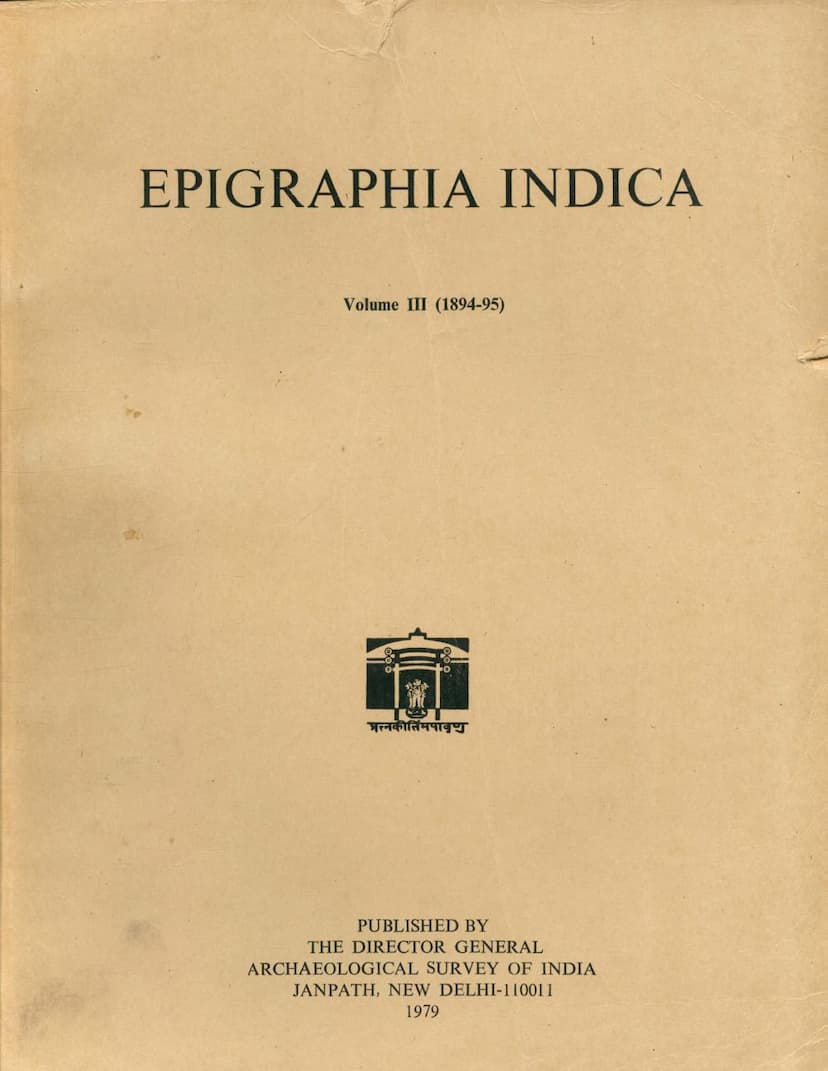Epigraphia Indica Vol 03
Added to library: September 1, 2025

Summary
The provided text is the third volume of "Epigraphia Indica," published by the Archaeological Survey of India. It contains a collection of inscriptions from various periods of Indian history, transcribed and translated by scholars like J. F. Fleet, E. Hultzsch, and F. Kielhorn. The majority of the inscriptions are in Sanskrit, written in various scripts, primarily Nagari and Grantha.
Here's a breakdown of the key aspects and themes, keeping in mind that this is a scholarly publication of ancient epigraphs:
Overall Purpose:
- Preservation and Study of Inscriptions: The primary goal of "Epigraphia Indica" is to publish accurate transcriptions and translations of ancient Indian inscriptions, making them accessible for historical, linguistic, and archaeological research.
- Shedding Light on Indian History: These inscriptions provide primary source material for understanding the political, social, religious, and economic conditions of ancient and medieval India, detailing dynastic lineages, royal grants, religious endowments, administrative practices, and social customs.
Key Themes and Content:
-
Dynastic Histories: Many inscriptions detail the genealogies of various ruling dynasties, including:
- Western Chalukyas: Pattadakal pillar inscription of Kirtivarman II (No. 1).
- Pandya Dynasty: Ranganatha inscription of Sundara-Pandya (No. 2).
- Eastern Ganga Dynasty: Alamanda plates of Anantavarman (No. 3).
- Vijayanagara Dynasty: Bitragunta grant of Samgama II. (No. 4), Satyamangalam plates of Devaraya II. (No. 5), Nallur grant of Harihara II. (No. 19), and Unamanjeri plates of Achyutaraya (No. 24).
- Rashtrakuta Dynasty: Paithan plates of Govinda III. (No. 15) and Torkhede plates of Govindaraja (No. 9).
- Yadava Dynasty: Babali inscription of the Yadava king Singhaņa (No. 18).
- Sinda Family: Stone inscription at Bhairanmatti (No. 33).
- Bana Dynasty: Udayendiram plates of Vikramaditya II. (No. 13).
- Chola Dynasty: Udayendiram plates of Vira-Chola (No. 14) and inscriptions of Chola chiefs (No. 12).
- Eastern Chalukya Dynasty: Chiplun plates of Pulikesin II. (No. 8).
- Local Dynasties: Buguda plates of Madhavavarman (No. 6), Mândhâtâ plates of Jayasinha (No. 7), Vanapalli plates of Anna-Vema (No. 10), Cochin plates of Bhaskara Ravivarman (No. 11), and Parlå-Kimedi plates of Vajrahasta (No. 31).
- Maurya Emperor: Siddapura edicts of Asoka (No. 22).
-
Royal Grants and Endowments: Numerous inscriptions record land grants made by kings to Brahmanas, temples, and Jaina monasteries. These grants often specify the boundaries of the land, the purpose of the endowment (e.g., for perpetual lamps, maintenance of ascetics, feeding Brahmans), and include imprecatory verses to deter interference with the donation.
-
Religious and Philosophical Content: Several inscriptions are dedicated to deities like Siva (e.g., Vijayêśvara, Lôkêśvara, Trailôkyêśvara), Vishnu (e.g., Ranganatha, Narasimha), and various Jaina Tirthankaras and preceptors (e.g., Mallishêņa, Ajitasêna). They reflect the religious landscape of the time, showcasing the patronage of different faiths.
-
Linguistic and Paleographic Information: The publication provides valuable insights into the evolution of scripts (Nagari, Grantha, Old-Kanarese, Telugu) and the Sanskrit language as it was used in different regions and periods. The editors often discuss peculiarities in orthography, grammar, and script.
-
Chronological and Geographical Data: The inscriptions often contain dates in Saka or Vikrama eras, which are crucial for establishing chronologies. They also mention place names, geographical features, and administrative divisions, aiding in the reconstruction of ancient Indian geography.
-
Analysis of Spurious Records: Notably, the volume includes a detailed analysis of spurious grants, particularly the Sudi copper-plate grant of Bûtuga (No. 25) and others related to the Western Gangas, highlighting the critical methodology used in epigraphy to identify forgeries based on palæography, anachronisms, and internal inconsistencies.
-
Specific Inscriptions of Note:
- Asoka's Edicts: The Siddapura edicts (No. 22) are significant for their contribution to understanding Asoka's Dhamma and the administrative structure of the Maurya empire in the Deccan.
- Cochin Plates of Bhaskara Ravivarman: (No. 11) is notable for mentioning a grant to a Jewish individual (Issuppu Iråppân), shedding light on the early presence of Jewish communities in India.
- Yadava Inscriptions: Several inscriptions document the reign of Yadava kings like Singhaņa (No. 18) and Bhillama (No. 30), contributing to the history of this significant South Indian dynasty.
In summary, "Epigraphia Indica, Vol. III" is a foundational work for the study of ancient Indian history, offering a scholarly compilation of diverse inscriptions that serve as direct evidence for reconstructing the past. It demonstrates rigorous epigraphical analysis, including the identification and critical evaluation of potentially spurious documents.